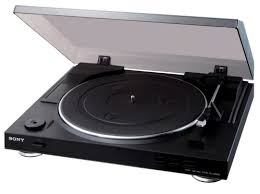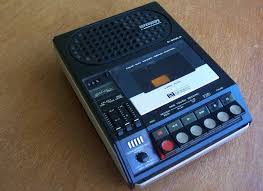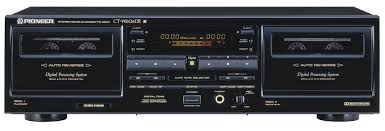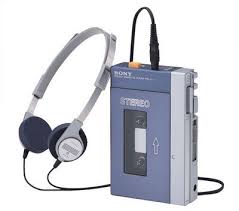MINIDISC:- A great idea in theory, Minidisc was the forerunner to the ipod, which eventually done for it. Affording much greater recording options than cassette tape, or even the slowly-emerging CD-Rs, Minidiscs were probably worst let down by their own marketing. They were expensive to buy per disc, the players was also not cheap, the recorders even moreso, and to add to that, only a very small handful of albums were ever released to Minidisc. The sound was excellent though, and you could record --- apparently --- over 1000 times and still get the same high quality. They were also the first recording medium to offer the possibility of scrolling album, artiste and track data on an LCD screen. They were, so far as I know, the ONLY medium to allow you to move tracks, once recorded, around, so that your last track could be your first and so on, and to allow partial deleting of tracks without affecting the rest of the recording. They should have taken over the world, but like laserdiscs, they were overtaken by superior, or at least better marketed and affordable technology.
 N
NEEDLE:-
N
NEEDLE:- see
STYLUS
P
PICTURE DISC:- Back in the days when albums and singles were released on vinyl, certain promotional, limited or special editions would not just be black vinyl (or in some cases, coloured vinyl), but would contain a picture, usually of the album or single sleeve artwork, on the actual record, so that you could watch it going around as the disc spun. Completely pointless, but very nice!
PLAYING PROCEDURE:- This was the big one! Back in t'olden days, to listen to an album you had to go through various steps.
Step 1: Remove the plastic dust sheet from the album cover by pulling it downward, or pulling the sleeve upwards.
Step 2: Gently slide the inner sleeve out from the right hand side of the album sleeve, being careful in case you had hastily repacked the album and the aperture was in fact at the edge rather than the top! Step 3: Take the record gently between both hands, holding it only by the edges, basically cupping it with the sides of your hands, as if offering a prayer or perhaps holding a goldfish bowl.
Step 4: Place the record, still holding it only by the edges, gently on the turntable.
Step 5: Lift the arm of the record player and gently blow any dust or dirt off the stylus.
Step 6: Check the speed, and adjust if necessary.
Step 7: Lift the arm, which automatically started the turntable moving.
Step 8: Carefully lower the arm down onto the edge of the record, so that the needle met the first groove, or track of the record.
Step 9: Sit back and listen, till side one ended and it was time to flip the record over and repeat steps 3-8, after which repeat steps 1-3 in reverse.
Select playlist and hit play? Hah! In my day, listening to a record was a carefully balanced art coupled with a militarily-precise operation!
PRE-RECORDED TAPE:- Simply put, an album on tape. This was the
official version, as opposed to one you taped off your mate's copy. So in those days you had only the option of buying the album on vinyl (record) or tape. Pre-recorded tapes tended not to be of the greatest quality, and in fact, unless you really needed the original, it was far preferable to tape the album onto a blank cassette, even if you owned the album and just wanted to hear it on your Walkman. The only good thing about them was that they were usually one or two pounds cheaper than the record.
R
RECORD:- A vinyl disc, almost always twelve inches in diameter for albums, and usually seven inches for singles. The odd EP could be ten inches across, though those were rather rare. Record was also often used as a general term for any release, ie “this is the new record from Dire Straits” etc.
 RECORDING LEVEL:-
RECORDING LEVEL:- Most albums were recorded at different sound levels, some louder than others, some much quieter. If you wanted to get your tape recordings to sound correctly, you tended to use a tape deck with a recording level you could control, via a slider or knob. You would first do a “test record”, by having the tape deck in pause and record, then play the album, check the level, adjust as necessary, then return the needle to the start and release the pause. Yes, you would have to do this for each track off each album if you were doing a compilation, but then again, if you were just recording one full album the record level would remain the same throughout. You could also use the Recording Level to fade out (or even in) any track, by starting the level at 0 (to fade in) and slowly (but not TOO slowly: there was an art to it!) raising it by increments till it was at the level you desired, or doing the reverse for fading out --- very handy for those live albums where you wanted the middle track...
RECORD PLAYER:- Also known as a Turntable, this was the device on which we all spun our albums and singles. It usually consisted of a rectangular box, with a perspex or glass lid, under which was a round platter which spun mechanically and on which the records were placed, and a long arm which, when not in use, sat on a raised stand parallel to the turntable, and when in use would moveout and over the disc, touching its stylus to the vinyl which then reproduced the music. There was also a speed selector, and on some old, cheap or self-contained models, controls for volume, bass etc, though on decent systems these controls were on the amp.
 RPM:-
RPM:- Or Revolutions Per Minute. Albums and singles were played at different speeds, 33 rpm for the former and 45 rpm for the latter (which led to the archaic term for singles, as “forty-fives”). Some Eps played at 33 as well, and if you had a really old record player you could have hours of fun for all the family slowing down records to 16 rpm for thaaaatttt reeeeealllllyyyyy slllllowwwwww feeling, or speedthemuptocrazyhighpitchedsqueals at 78! But none of us did that. Well, not much anyway.
S
SCRATCH:- Record players were not the shock-proof beasts of today, and it only took one misstep or fall against it and the needle would skip across the disc, usually tearing a scratch across its surface, often across several tracks. A stylus carelessly dropped onto a record could have the same result. Scratches, as you might expect, were not good and resulted in the record skipping, or popping, hissing or crackling. Scratches could also cause a record to stick annoyingly, so you could have the following effect: “She loves you yeah... loves you yeah... loves you yeah...” You get the picture.
SIDE:- Every record, whether a single, album or EP, had two sides, and each was recorded on, with the albums usually split evenly, with say 5 tracks per side. The first side, the beginning of the album, was always named Side A, while its reverse was Side B. Oddly, even a double or triple album would have each record labelled Side A and B, no C, D,E or F. This is also where a phrase you may have heard, the “B-side”, comes from, as singles were released with the hit, or expected hit, on side A, and another track, sometimes not on the album, sometimes a live version, sometimes an extended version, on the B-side.
SINGLE:- Same as today really: a track released from an album in the hope it will get into the charts was called a single, released on a small, seven-inch vinyl or often an extended twelve-inch disc.
SKIP:- As in
SCRATCH above, damage to a record could cause the stylus to miss a certain point in the groove and skip over it, so you would get something like “She lo- you, yeah, yeah, yeah!” Badly-maintained or damaged records could have a few skips in them. These, like scratches, were in some small measure treatable, via a
WEIGHTED ARM.
STICK:- Again, as in
SCRATCH above. This could really bring your enjoyment of an album to an end, as the only way to get past a stick on the record was to carefully lift the needle out of the groove and replace it beyond the offending portion. As this was all done by line-of-sight and luck (mostly luck), invariably you would get something like this: “She loves,loves,loves,loves,loves... with a love like that, you know it can't be bad!” Very frustrating, which is another reason why we all tried to maintain our records to the best of our abilities AND always always ALWAYS checked carefully for scratches or any other imperfections on any second-hand albums we bought. And we bought many.
SLEEVE:- Or Album Sleeve. The crowning glory of any record, its outer face which was usually a painting, picture, design or concept in normally bright colours and often a real work of art. What is today laughingly called “album art” is a tiny copy of what we who bought the albums got for our money. An album cover was often the first thing that attracted us to a record, and I honestly doubt that anyone ever had a record in their collection, by choice, that had no sleeve. The sleeve was usually made of waxed card, and had a nice silky feel to it.
STYLUS:- Or Needle, the business end of the playing arm of a record player. The stylus travelled along the grooves cut in a record, allowing the music to be heard. A clean, undamaged stylus was something you had to have if you wanted to play records. The stylus was carried in the cartridge, which in turn formed the furthermost part of the arm. Styli wore out over time, and could be replaced. They had to be treated with care, as even dust or hair caught on one could cause it to skip across a record, stick in it or even scratch it, or if not actually do damage, it could also muffle the sound of the record.
 T
TAPE:-
T
TAPE:- See
CASSETTE. Also the practice of recording, eg “I'm going to tape this new album”.
TAPE COUNTER:- A simple counter docked to the tape deck, which counted up (when playing or recording) or down (in reverse mode) a sequence of numbers from 0 to about 200 or so, depending on how long the tape you were using was. It did not, unfortunately, equate one point for one second, or anything, but you got to know how much to count up, how much of your tape was left or how far you needed to go back, based on the counter. Also very handy for dubbing.

TAPE RECORDER:- Also called Tape Decks, Cassette Recorders and Cassette Decks, these were the apparatus which spun the tape cassettes and allowed them to be either played or recorded, or both. Tapes would be slotted in by pushing the twin spindles of the cassette onto pinions in the deck, or in more sophisticated models, by slotting the cassette into the well of the door that opened, and then closing it, which connected the spindles with the pinions. Most decks had the following controls: PLAY, PAUSE, REW (Rewind), FF (Fast Forward), RECORD, STOP. Most often a tape would snap off, the STOP button being automatically engaged, when the tape reached the end, either playing or recording, though on some models the Auto-reverse function could be applied, meaning that when the tape reached the end of one side it would automatically start playing the other side. Tape recorders began life initially as hand-held ones with self-contained motors and speakers (you might see them in some very old police programs, or look at “Life on Mars” for an example) --- reporters used to carry them around,usually with a big bulky microphone attached. Then they became part of stereo systems, and finally they were released into the wild, as much smaller versions of their original selves, generally though incorrectly called Walkmans.

 TRACK:-
TRACK:- Single songs on albums were called tracks. This could also refer to the grooves cut into the vinyl, each of which was a track.
TURNTABLE:- Another name for the record player, but more properly describing the actual platter, round and usually made of metal, covered with a rubber mat upon which the record was placed, and which spun on a motor as the stylus moved across it.
TWELVE-INCH SINGLE:- As the name suggests, a disc which measured 12 inches across, however 12-inch singles, though the size of an album and usually played at 33rpm, usually contained extended versions of the single, as well as alternate versions, other B-sides etc. 12-inch singles were often Picture Discs or even Shaped Discs. Quite often, versions on the twelve-inch were not available anywhere else, not even on the album.
TWIN CASSETTE DECKS:- If you wanted to do proper dubbing, you had to have a twin cassette deck, also of course called twin tape deck. No prizes for guessing what this was: two cassette decks on the same unit, which allowed you to record one tape to another. Quite often on a twin deck only one of them would have a record facility, this being known as the dubbing deck, or deck B, while the playing deck was deck A. Again, to perform dubbing correctly, you really had to have recording level control. Also a feature on twin decks was AutoSync, which allowed you to either a) put your blank cassette in deck B, load in your original tape in deck A, select AutoSync and when tape A began playing tape B would automatically start recording, or b) listen to two tapes one after the other. When the one in deck A ran out, deck B would start up.
V
VINYL:- The plastic of which every record in the sixties, seventies and eighties was made, and which is to some extent still in production, and I believe may be coming back into vogue. Vinyl was relatively strong, as in, you could bend an album slightly and it would not crack, you could drop it and nine times out of ten it would not break. This was not, however, suggested practice. Vinyl was usually black, except in the case of picture/colour/shaped discs.
W
WALKMAN:- Specifically referring to the portable tape player created by Sony in the eighties, this term came to be applied to all small portable cassette players. For their time, they were revolutionary, about the size of an iphone (though much bulkier) and running typically on two AA batteries, with attached headphones. Some had radios, and some few had recording ability, though this was largely only for speech and the odd bootleg recording. Walkmans took our music and gave it legs. For the first time ever, we could listen to our music on the go. Of course, you had to have a few tapes with you if you were going a distance, but even then, one normal C90 tape would last you an hour and a half, which was not bad. Plus, unlike the unwieldy later Discmans, you could shove four or five tapes into your coat pocket or bag, and that gave you about seven hours listening time. You did have to change the tapes at intervals of course, but for us, this was the cat's pyjamas.
 WEIGHTED ARM:-
WEIGHTED ARM:- Some turntables (the more expensive ones, natch) came with a small knob or screw that could be turned, which increased the weight the stylus put on the record. This quite often was successful in repairing small scratches or skips (or, more correctly, allowing the stylus to move over them without getting stuck or jumping. The imperfections usually remained, just were not a bother to the heavier stylus). Some enterprising, and poorer, people achieved the same effect, with varying degrees of success, by sellotaping a penny to the head of the arm.
And that's my guide to twentieth-century music technology! If you're from my era, hope that brought back some memories for you. If you're a lot younger, then I hope you now appreciate what a special thing it was for us oldies to buy, play and maintain our record and tape collections. You kids today, don't know you're born, with digital downloads, itunes, Apple this, Microsoft that, Youtube, wasn't like that in my day, blah blah blah... 